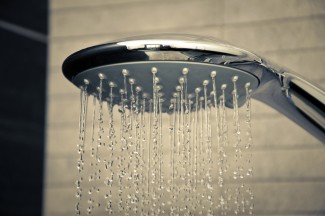From the rustic 1850s pump shower to the 1920s Humphrey automatic to today’s modern units, water heaters have made great strides in performance and efficiency. On April 16, 2015, water heaters will take the next great stride when manufacturers must comply with new Department of Energy (DOE) efficiency standards. The most common water heaters manufactured on and after this date will get a modest boost in efficiency, while units over 55 gallons will shift to next-generation technology, cutting utility bills by one-fourth to one-half depending on the technology.
What is covered?
Completed by DOE in 2010, the standards cover gas, oil and electric residential tank water heaters, usually between 20 and 80 gallons. (DOE also upped the efficiency levels for instantaneous—tankless—gas water heaters, but most models already meet the new efficiency levels.) Water heating is on average the second largest household energy expense behind space heating, representing about 18% of total household energy consumption in the US. Consumers annually pay an average of about $170 (gas) and $300 (electric) to operate a water heater just meeting current efficiency standards. About 50% of US households use natural gas water heaters, 41% electric, and the remainder propane or oil.
New standards will save money for consumers, save energy, and reduce emissions
DOE estimates that the new efficiency measures will save 2.6 quadrillion Btus (quads) of energy over 30 years and net consumers up to $8.7 billion in savings. Over the same period, the standards will reduce CO2 emissions by 154 million metric tons. To put these long-term savings in perspective, the savings are enough to meet the total energy needs of 13 million typical US homes for a year, and the CO2 savings are equivalent to taking 32 million passenger cars off the road for a year.
Most storage water heaters to get a modest boost in efficiency
For storage water heaters with volumes of 55 gallons and below (representing the vast majority of sales), the new standards will increase the efficiency of typical-sized units by 4% on average. Manufacturers plan to meet the efficiency levels with incremental improvements such as improved heat exchangers (gas) and more insulation. Water heaters that comply with the new standards are already on the market, including models from the three large domestic manufacturers (A.O. Smith, Bradford White, and Rheem) that make most water heaters sold in the United States.
Big jump in efficiency for storage water heaters over 55 gallons
Water heaters larger than 55 gallons will see a much bigger jump in efficiency. The new standards for these larger water heaters can be met using electric heat pump and gas condensing technology. Heat pump water heaters save at least 50% and condensing gas units about 25% compared to today’s conventional water heaters.
Heat pump water heaters (also known as hybrid water heaters) transfer heat from the surrounding air to the water. When hot water demand is very high or the ambient air temperature drops below a threshold level, the hybrids switch from heat pump mode to electric resistance mode. According to DOE’s analysis, a consumer purchasing these highly efficient units will save more than $600 over the life of the product compared to a water heater just meeting the current efficiency standards. While the upfront cost to purchase and install these products is higher, consumers will recoup the added cost in about six years on average through lower electricity bills. Consumer Reports tested heat pump water heaters and found that “Those we tested provided annual savings of about 60% over electric-only models.”
One key concern about heat pump water heaters is low temperature operation. When the heat pump water heater operates in electric resistance mode, it doesn’t save energy or money compared to a conventional unit. Research by the Northwest Energy Efficiency Alliance showed that some early heat pump water heater models were cutting over to electric resistance mode at relatively high ambient temperatures. Manufacturers have been working to lower the minimum temperature at which water heaters operate in heat pump mode. Recent models have made significant progress, ensuring heat pump operation down to ambient temperatures as low as 35 degrees. The vast majority of utility programs in the Northwest point to the Northern Climate Specification Qualified Products List to determine whether a heat pump water heater qualifies for utility incentives
Condensing gas water heaters are not as prevalent as heat pump water heaters, but consumers have more choices today than they did just a few years ago. Conventional gas water heaters lose much of the energy burned up the flue. Condensing water heaters are designed to reclaim much of this escaping heat by cooling exhaust gases well below 140 degrees F, where water vapor in the exhaust condenses into water.
Details on the new standard levels
The table below shows the current and new standards for typical-sized storage units. The water heater standards vary as a function of tank size. The energy factor (EF) is the ratio of useful energy output from the water heater to the total amount of energy delivered to it.
Size change: a bit bigger, but there are options
A review of manufacturer websites shows that the height and/or diameter of some conventional products will increase 1 to 2 inches due to added insulation (some less than an inch). For many homes, particularly those with basement installations, the small increase in size will have little impact. Consumers with space constraints (e.g., water heaters in closets or crawl spaces) should consult manufacturer websites or local installers for options. Consumers may find that a product from one manufacturer fits better in their tight space than a similar product from a different manufacturer.
Manufacturers prepared for changes
Manufacturers are offering webinars, online videos, and educational materials to guide consumers, contractors, and installers through the changes. Several website include cross-reference guides to help consumers compare current models to models meeting the new standards. You will find most of the educational materials on manufacturer websites under NAECA (National Appliance Energy Conservation Act), the legislation that authorized appliance efficiency standards.
What about grid-enabled water heaters?
Utilities represented by the National Rural Electric Cooperative (NRECA) and the American Public Power Association, along with PJM Interconnection (regional grid operator) raised concerns that demand-response programs for water heaters over 55 gallons would suffer if they were required to switch to heat pump water heaters. In these programs, utilities control the use of grid-enabled (connected) water heaters to manage energy use at peak times, resulting in large savings. Though some stakeholders claim that heat pump water heaters can provide the services that NRECA and others desire, not all stakeholders are convinced that they will work as well. A legislative fix to establish a class of water heaters for demand-response programs is pending in Congress. In addition, some manufacturers have petitioned for waivers for this application.



